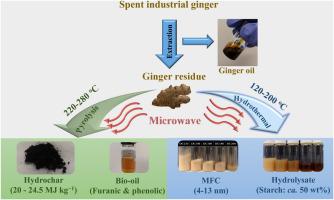Journal of Hazardous Materials ( IF 12.2 ) Pub Date : 2020-07-06 , DOI: 10.1016/j.jhazmat.2020.123400 Yang Gao 1 , Mustafa Z Ozel 1 , Tom Dugmore 1 , Allyn Sulaeman 1 , Avtar S Matharu 1

|
An integrated biorefinery approach using spent industrial ginger waste for resource recovery is reported. Valuable products including ginger oil, starch, microfibrillated cellulose (MFC), bio-oil and hydrochar were obtained. Approximately 4 % ginger oil, with a profile similar to commercial ginger oil, can be recovered via Soxhlet or Supercritical CO2 + 10 %EtOH extraction. The oil-free ginger residues were processed using two microwave techniques: starch, MFC and sugar-rich hydrolysates were firstly gained through hydrothermal microwave processing (120–200 °C in water alone), whilst chemical-rich bio-oils and energy-dense hydrochar (20–24.5 MJ kg−1) were obtained via conventional microwave pyrolysis (220–280 °C). The ginger MFC exhibited increased propensity to form microfibrillated cellulose (as evidenced by Transmission Electron Microscopy) with increasing temperature. Nanocrystalline cellulose was produced at the highest processing temperature (200 °C). These changes are commensurate with the leaching and decomposition of the amorphous regions within cellulose. The molecules and materials isolated have further downstream applications and, thus, compared to current low value resolution methods (dumping, burning or animal feed), spent industrial ginger waste is a significant resource for consideration within a biorefinery concept.
中文翻译:

针对废工业生姜废物的生物精炼策略。
据报道,一种利用废工业生姜废物进行资源回收的综合生物精炼方法。获得了姜油、淀粉、微纤化纤维素(MFC)、生物油和水炭等有价值的产品。通过索氏提取或超临界 CO 2 + 10%EtOH 萃取,可以回收大约 4% 的姜油,其特征与商业姜油相似。使用两种微波技术对无油姜渣进行加工:首先通过水热微波加工(仅在水中进行 120–200 °C)获得淀粉、MFC 和富含糖的水解产物,同时获得富含化学物质的生物油和能量密集的产品。水炭(20–24.5 MJ kg −1 )通过传统的微波热解(220–280 °C)获得。随着温度的升高,生姜 MFC 表现出形成微纤丝纤维素的倾向增加(如透射电子显微镜所证明的)。纳米晶纤维素是在最高加工温度(200°C)下生产的。这些变化与纤维素内无定形区域的浸出和分解相称。分离出的分子和材料具有进一步的下游应用,因此,与当前的低价值分辨率方法(倾倒、燃烧或动物饲料)相比,废工业生姜废物是生物精炼概念中值得考虑的重要资源。










































 京公网安备 11010802027423号
京公网安备 11010802027423号